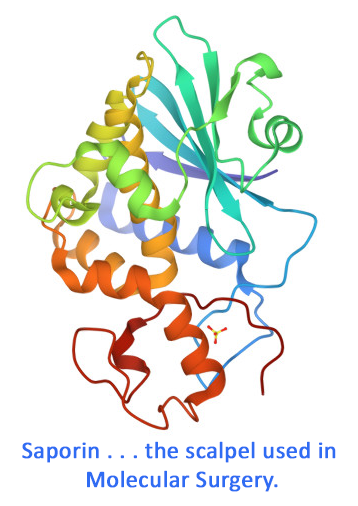CD44 is a cell-surface glycoprotein that plays a role in cell-cell interactions, cell adhesion and migration. CD44 is a receptor for hyaluronic acid and also interacts with other ligands, such as osteopontin, collagens, and matrix metalloproteinases. CD44 participates in a wide variety of cellular functions such a lymphocyte activation, recirculation and homing, hematopoieses, and tumor metastasis. CD44 has been considered an activity marker and potential novel therapeutic target in multiple sclerosis and is associated with relapses in non-small cell lung cancers.
Anti-CD44-SAP is a bonded toxin between biotinylated rat monoclonal antibody to mouse CD44 (clone IM7) and the secondary conjugate Streptavidin-ZAP containing the ribosome-inactivating protein, saporin. It eliminates cells expressing all isoforms of CD44 with expected reactivity in mouse, human, baboon, monkey, bovine, cat, dog, ferret, horse, pig, cynomolgus monkey, and rhesus monkey.
Anti-CD44-SAP is available individually (Cat. #IT-72) or as a kit (Cat. #KIT-72) which includes Anti-CD44-SAP and BIgG-SAP rat (Cat. #IT-73).
keywords: CD44, cell adhesion, cell migration, cell-cell interaction, cell-surface, clone IM7, collagen, doxorubicin, glycoprotein, hematopoieses, homing, Hyaluronic acid, isoforms, liposome-encapsulated, lymphocyte activation, matrix metalloproteinases, metastasis, migration, mouse, MS, Multiple sclerosis, murine, non-small cell lung cancers, novel therapeutic, osteopontin, recirculation, therapeutic, tumor metastasis, streptavidin, saporin, brain, neuroscience
Light-triggered, efficient cytosolic release of IM7-saporin targeting the putative cancer stem cell marker CD44 by photochemical internalization.
Bostad M, Kausberg M, Weyergang A, Olsen C, Berg K, Høgset A, Selbo P (2014) Light-triggered, efficient cytosolic release of IM7-saporin targeting the putative cancer stem cell marker CD44 by photochemical internalization. Mol Pharm 11:2764-2776. doi: 10.1021/mp500129t
Summary: CD44 is known as a common cancer stem cell (CSC) marker. Given that CSC's seem to have the ability to resist many therapeutic agents, the authors investigated the use of photochemical internalization (PCI) while targeting CD44-expressing CSC's. An immunotoxin was constructed by biotinylating a pan CD44 antibody and combining it with Streptavidin-ZAP (Cat. #IT-27) at a 4:1 biotinylated antibody to Streptavidin-ZAP molar ratio. Various cancer cell lines were incubated with the toxin at a concentration of 0.825 nM. The toxin showed specific cytotoxicity to CD44-expressing cell lines, demonstrating the efficacy of PCI in conjunction with targeted toxins to treat some cancers
Related Products: Streptavidin-ZAP (Cat. #IT-27), Anti-CD44-SAP (Cat. #IT-72)
CD44 signaling mediates high molecular weight hyaluronan-induced antihyperalgesia.
Ferrari LF, Khomula EV, Araldi D, Levine JD (2018) CD44 signaling mediates high molecular weight hyaluronan-induced antihyperalgesia. J Neurosci 38(2):308-321. doi: 10.1523/JNEUROSCI.2695-17.2017
Objective: To study the role of the cognate hyaluronan receptor, CD44, signaling in anti-hyperalgesia induced by high molecular weight hyaluronan (HMWH).
Summary: These results demonstrate the central role of CD44 signaling in HMWH-induced anti-hyperalgesia, and establish it as a therapeutic target against inflammatory and neuropathic pain.
Usage: Both IB4-SAP and SSP-SAP were diluted in saline to doses previously shown to deplete nonpeptidergic (3.2 mcg/rat for IB4-SAP) and peptidergic (100 ng/rat for SSP-SAP) fibers. The toxins were administered intrathecally, in a volume of 20 mcl, 14 d before intradermal injection of LMWH on the dorsum of the hindpaw. Treatment with either conjugate, or a combination of the two, did not significantly affect mechanical nociceptive threshold.
Related Products: IB4-SAP (Cat. #IT-10), SSP-SAP (Cat. #IT-11), Anti-CD44-SAP (Cat. #IT-72)
browse all references for this product | back to top


Reviews
There are no reviews yet.